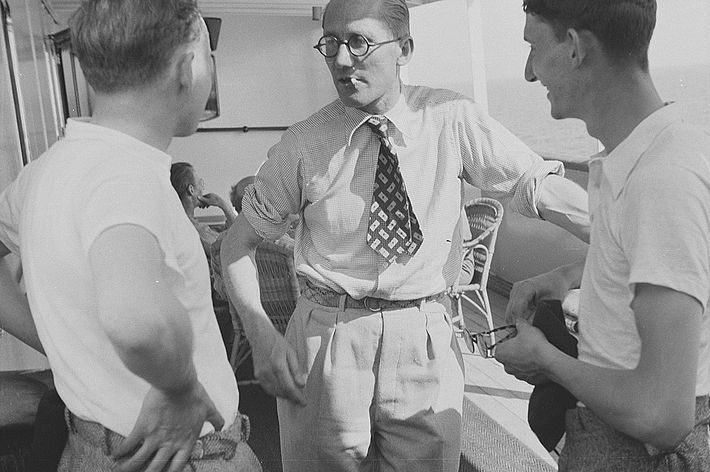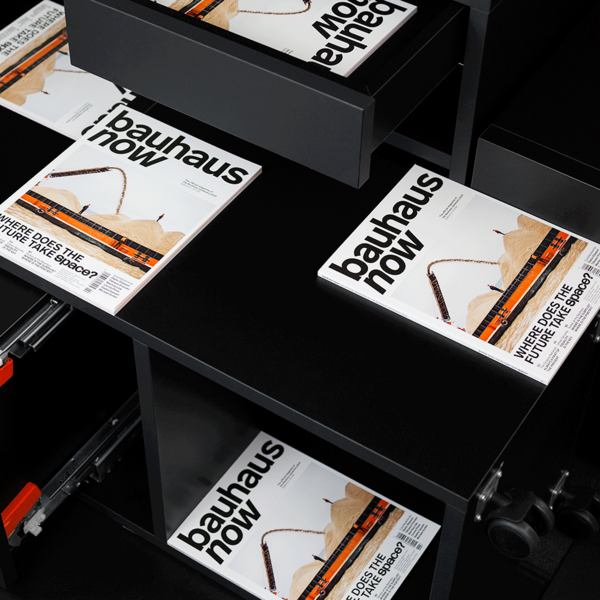Bauhaus aboard
Divine weather, a sleek steamship and a relaxed public who had apparently managed on a cruise to join work and leisure in perfect reconciliation: The pictures of the Fourth CIAM-Convention on board the French ship Patris II reveal an incredibly casual, almost perfect setting between a Mediterranean sun and tangy sea breezes. Yet, the picture darkens right away as soon as a person grasps the historical context. The Convention in the summer of 1933 began exactly two weeks after the National Socialists closed down the Bauhaus in Berlin.

[Translate to English:] headline
Actually, the Convention should have taken place in Moscow. Yet, the increasing degradation of Modernism by Stalin compelled the organizers to look for a new venue at the last minute. From today‘s perspective, it seemed to be a shrewd decision that they consciously had recourse to a ship and organised a two-week trip from Marseille to Athens and back again. Without this exceptional venue and the portentous timing the Convention that was entitled „The Functional City“ would have been only one of many meetings that historians of architecture concern themselves with, who study the history of modern urban planning. Yet, the unusual circumstances have made the Fouth Convention of the European Architects Association, Congrès International d‘Architecture Moderne (CIAM) even today perhaps the most legendary meeting of the architectural avantgarde in the period between the world wars.
[Translate to English:] headline
The myth of the Convention had definitely a great deal to do with the subject matter. The members of the CIAM had embarked upon an extremely ambitious programme. As the conference was approaching, they were preparing cartographic analyses of 34 international cities that were going to be discussed on board. The basis on which to work was a standardised mapping method that the then president of CIAM, the Dutch architect and urban planner, Cornelius van Eesteren, had devoloped. The goal of the exercise was – due to a unified mapping language cities could easily be compared with one another. This would produce generally valid evidence as to the problems of big cities that have grown in history and the challenges of modern urban planning. The implied goal of the future – planning the perfect „functional“ city.

[Translate to English:] headline
In detail, there were naturally a few points of controversy. Yet, the general strategic course was shared by everybody on board. The old, densely populated, dirty city was rejected. In its place, the convention participants demanded neatly structured cities with a well organised road network. Today‘s often chastised functional separation of work, dwelling, recreation and transport was at that time undisputed. In view of poor hygiene and the over-crowded flats in many cities, this should not surprise anyone.
[Translate to English:] headline
Most of the demands of the CIAM were common knowledge in urban planning. The actual achievement of the Convention should be seen not so much in the originality of the questions posed, but in the specific development and pointed interpretation of the subject matter. What the CIAM actually accomplished in masterly fashion was publically propagating their work. Among those who were responsible for this was the Swiss art historian Sigfried Giedion, who as a tireless publicist, intermediary and net worker consistantly beat the big drum for this. Even when internationally successful architects such as Cornelius van Eesteren, Walter Gropius and Le Corbusier could be publically seen as the creative heads of the CIAM, it was nevertheless Giedion, who acting as secretary general deciseively guided the fortunes of the elite association and ultimately was responsible for their success.
[Translate to English:] headline
As the Fourth Convention was approaching, Giedion managed to pull off a special coup. He commissioned the many-sided, highly talented Hungarian photographer László Moholy-Nagy to produce a film about the meeting. Since 1925, Giedion had been friends with the famous „Bauhaus-Meister“. On a number of holiday trips the art historian and the unorthodox photographer took photos together and discussed topics on a theoretical level. With his film „The architects‘ Congress“, Moholy-Nagy contributed decisively to the legends that grew up around this meeting. The mixture he employed of spectacular lateral-telescope methods, abstract image compositions and anecdotal episodes fit the event perfectly and put it even today within easy reach.
As successful as Giedion‘s film production had been, so much of a failure was his attempt to get the former Bauhaus Director Walter Gropius to attend the Convention. Gropius had worked substantially on the conception and organisation of the Convention. In addition, the employees of his office under the direction of a former Bauhaus student, Wils Ebert, drew two gigantic analytical charts of Berlin employing the measurements 420 x 480 centimetres. These unwieldy monumental works dwarfed even the maps of Paris, London and Detroit. Yet, they reflect both Gropius‘ desire as well as his painstaking efforts to probe the phenomenon of the metropolis using drawing analyses.
Yet, in spite of all requests and urgings from Zürich: In view of the National Socialistic threats, Gropius had left Germany by that time and was trying to gain a foothold in London. He had recognized the signs of the time and was now busy organising a new life in exile, while his colleagues in the Mediterranean were dreaming of plans for the perfect cities.
Although prominent heads of Bauhaus – apart from Moholy-Nagy – were also not on board, Walter Gropius was not the only one who played an important part in the background. Just as important was Ludwig Hilberseimer, who was known for his incredibly austere and reduced urban utopias. He taught at the Bauhaus urban planning to Hubert Hoffmann and Wilhelm Hess as well as the Dutchman Cornelius van der Linden. Although the three young architects were complete unknowns on the international scene, they ventured onto the meeting with an analysis of Dessau. The conference participants must have been quite impressed. The three colleagues from the Bauhaus surprised them with an extremely carefully elaborated presentation that exceeded everything that their colleagues had ever worked on.
[Translate to English:] headline
Full of youthful enthusiasm, they not only drew the required standard maps, but produced a 48.page Leporello. They worked with charts, pictures, graphs, diagramms, texts, maps as well as with student drafts that originated at the Bauhaus. They combined and collaged all this producing an extensive publication. They discussed every page in detail with Hilderseimer. He was delighted as to what results his instructions had achieved. Hoffmann, Hess and Van der Linden calculated exactly how much the production of the Leporello had cost. They also set up a plan to mass-produce this and sell it. In graphic and exciting language that at the same time was analytically profound, they wanted to convey the knowledge and discoveries of Modernism that were being made in urban development, as they were intensively taught at Dessau since the time of Hannes Meyer, to a wider public. But with National Socialism growing stronger by the hour the publication project petered out very quickly.

[Translate to English:] headline
Hovering serenely over all these activities was the commanding figure of Le Corbusier. In addition to the German, Dutch and Swiss national groups, it was also the „Frenchman-by-choice“ Le Corbusier, who had a huge impact on the programme and the public perception and appreciation of the CIAM in the period between the two wars. He was also the one, who just ten years later after the Convention published the results of the meeting offering his own interpretation entitled „The Charta of Athens“. Even today every architect should be aware of the minimum content and intent of this booklet that appeared in 1942. Never again would such ideas involving modern urban planning be expressed in a more compact and programmatic manner. It will probably never be fully appreciated how great the influence of the „Charta of Athens“ had been on the field of urban planning. Yet, both its defenders as well as its detractors attach great importance to this publication.
In his book Le Corbusier honed his views even more and laid out clear guidelines as to how the „functional city“ had to look. In spite of all the modernistic enthusiasm that the Convention generated, the CIAM was interested in something else. It wanted to come up with solutions through proper analysis and have this comprehensive mapping material published so that it could be made available to a wider public and used as a constructive platform for further work. These sober and somewhat didactic aspirations were a marked contrast to the relaxed mid-summer atmospher on the ship and the hope of enjoying the good life that was now in full swing on the trip.
This is all the more significant since shortly afterwards the world would sink into the chaos of WW II. Germany was the home and hearth of this aggression. In addition, we see the desolate economic condition, which was a result of the Great Depression of 1929. For this reason, Bauhaus was not so well represented on board the Patris II as might have been expected. Most of the German architects had more pressing problems in the summer of 1933 that to travel to Marseille and take a cruise on the Mediterranean.
[GH 2018: Translation: JG]


